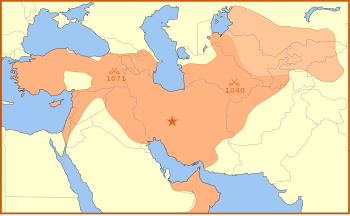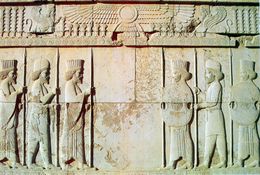الدولة السلجوقية
الدولة السلجوقية دولت سلجوقیان Dawlat-i Saljūqiān Great Seljuq Empire | |||||||||||||||||||||||||
|---|---|---|---|---|---|---|---|---|---|---|---|---|---|---|---|---|---|---|---|---|---|---|---|---|---|
| 1037–1194 | |||||||||||||||||||||||||
 Great Seljuq Empire in its zenith in 1092, upon the death of Malik Shah I | |||||||||||||||||||||||||
| العاصمة | Nishapur Rey | ||||||||||||||||||||||||
| السلطان | |||||||||||||||||||||||||
• 1037 - 1063 | Tuğrul Beg (first) | ||||||||||||||||||||||||
• 1118 - 1153 | Ahmed Sanjar (last) | ||||||||||||||||||||||||
| التاريخ | |||||||||||||||||||||||||
• Tugrul Beg formed the state system | 1037 | ||||||||||||||||||||||||
• Replaced by the Khwarezmian Empire[1] | 1194 | ||||||||||||||||||||||||
| |||||||||||||||||||||||||
الدولة السلجوقية أو الإمبراطورية السلجوقية الكبرى، (فارسية: دولت سلجوقیان)، هي إمبراطورية فارسية [2][3][4][5][6][7] اسلام|اسلامية في العصور الوسطى، أسسها الأوغوز أحد فروع الغزونيون التورك [8] والتي امتدت أراضيها من هندوكوش إلى شرق الأناضول ومن آسيا الوسطى إلى الخليج العربي.
تأسيس الأسرة
ينتمي السلاجقة إلى إحدى العشائر المتزعمة لقبائل الغز التركية. دخلت هذه العشيرة في الإسلام أثناء عهد زعيمها سلجوق سنة 960 م. دخلوا بعدها في خدمة القراخانات (قره خانات) في بلاد ما وراء النهر. قام أحفاد سلجوق، طغرل (1038-1063 م) و جغري (1038-1060 م) بتقسيم المملكة إلى نصفين. النصف الغربي و قاعدته إصفهان، النصف الشرقي و قاعدته مرو. بعد انتصاره على الغزنويين سنة 1040 م بالقرب من دنكان توسعت مملكة طغرل بك إلى الغرب أكثر. ثم ضمت فارس إليها سنة 1042 م،
السلاجقة الكبار
جزء من سلسلة عن |
|---|
| تاريخ إيران |
 |
|
خط زمني |
Tugrul and Chagri Beg
ألب أرسلان
جلال الدولة ملك شاه
الحكم
الحملة الصليبية الأولى
الحملة الصليبية الثانية
- See also: الحملة الصليبية الثانية, Zengi, نور الدين
انقسام الإمبراطورية
- See also: سلطنة الروم, Atabegs
قائمة أباطرة الدولة السلجوقية
- سلجوق بك (سميت باسمها)
- طغرل بك (1037 - 1063) (المؤسس)
- ألب أرسلان (1063 - 1072)
- جلال الدولة ملك شاه (1072 - 1092)
- محمد (1092 - 1094)
- Barkiyaruq (1094 - 1105)
- ملك شاه الثاني (1105)
- محمد (1105 - 1118)
- أحمد سنجر (1118 - 1153)
غزو الخوارزميين والأيوبيين
- انظر أيضا:صلاح الدين, أيوبيون, الإمبراطورية الخوارزمية
- Khorasani Seljuks in Khorasan and Transoxiana. Capital: Merv
- Kermani Seljuks
- Sultanate of Rum. Capital: Iznik (Nicaea), later Konya (Iconium)
- Atabeghlik of Salgur in Iran
- Atabeghlik of Ildeniz in Iraq and Azerbaijan. Capital Hamadan
- Atabeghlik of Bori in Syria. Capital: Damascus
- Atabeghlik of Zangi in Al Jazira (Northern Mesopotamia). Capital: Mosul
- Turcoman Beghliks: Danishmendis, Artuqids, Saltuqids and Mengujegs in Asia Minor
- Khwarezmshahs in Transoxiana, Khwarezm. Capital: Urganch
معرض الصور
Toghrol Tower, a 12th century monument south of Tehran in Iran commemorating Togrul.
Head of male royal figure, 12-13th century, found in Iran.
Shatranj chess set, glazed fritware, 12th century, from Iran. New York Metropolitan Museum of Art.
الهوامش
- ^ Grousset, Rene, The Empire of the Steppes, (New Brunswick:Rutgers University Press, 1988),159,161; In 1194, Togrul III would succumb to the onslaught of the Khwarizmian Turks, who were destined at last to succeed the Seljuks to the empire of the Middle East.
- ^ M.A. Amir-Moezzi, "Shahrbanu", Encyclopaedia Iranica, Online Edition, (LINK): "... here one might bear in mind that non-Persian dynasties such as the Ghaznavids, Saljuqs and Ilkhanids were rapidly to adopt the Persian language and have their origins traced back to the ancient kings of Persia rather than to Turkish heroes or Muslim saints ..."
- ^ Josef W. Meri, "Medieval Islamic Civilization: An Encyclopedia", Routledge, 2005, p. 399
- ^ Michael Mandelbaum, "Central Asia and the World", Council on Foreign Relations (May 1994), p. 79
- ^ Jonathan Dewald, "Europe 1450 to 1789: Encyclopedia of the Early Modern World", Charles Scribner's Sons, 2004, p. 24: "Turcoman armies coming from the East had driven the Byzantines out of much of Asia Minor and established the Persianized sultanate of the Seljuks."
- ^ Grousset, Rene, The Empire of the Steppes, (Rutgers University Press, 1991), 161,164; "..renewed the Seljuk attempt to found a great Turko-Persian empire in eastern Iran..", "It is to be noted that the Seljuks, those Turkomans who became sultans of Persia, did not Turkify Persia-no doubt because they did not wish to do so. On the contrary, it was they who voluntarily became Persians and who, in the manner of the great old Sassanid kings, strove to protect the Iranian populations from the plundering of Ghuzz bands and save Iranian culture from the Turkoman menace."
- ^ Possessors and possessed: museums, archaeology, and the visualization of history in the late Ottoman Empire; By Wendy M. K. Shaw; Published by University of California Press, 2003, ISBN 0520233352, 9780520233355; p. 5.
- ^
- Jackson, P. (2002). Review: The History of the Seljuq Turks: The History of the Seljuq Turks.Journal of Islamic Studies 2002 13(1):75-76; doi:10.1093/jis/13.1.75.Oxford Centre for Islamic Studies.
- Bosworth, C. E. (2001). Notes on Some Turkish Names in Abu 'l-Fadl Bayhaqi's Tarikh-i Mas'udi. Oriens, Vol. 36, 2001 (2001), pp. 299-313.
- Dani, A. H., Masson, V. M. (Eds), Asimova, M. S. (Eds), Litvinsky, B. A. (Eds), Boaworth, C. E. (Eds). (1999). History of Civilizations of Central Asia. Motilal Banarsidass Publishers (Pvt. Ltd).
- Hancock, I. (2006). ON ROMANI ORIGINS AND IDENTITY. The Romani Archives and Documentation Center. The University of Texas at Austin.
- Asimov, M. S., Bosworth, C. E. (eds.). (1998). History of Civilizations of Central Asia, Vol. IV: The Age of Achievement: AD 750 to the End of the Fifteenth Century, Part One: The Historical, Social and Economic Setting. Multiple History Series. Paris: UNESCO Publishing.
- Dani, A. H., Masson, V. M. (Eds), Asimova, M. S. (Eds), Litvinsky, B. A. (Eds), Boaworth, C. E. (Eds). (1999). History of Civilizations of Central Asia. Motilal Banarsidass Publishers (Pvt. Ltd).
16 Fazli Konus, "Selcuklular Bibliyografyası", Konya, 2006, p. 410
المصادر
- Previte-Orton, C. W (1971). The Shorter Cambridge Medieval History. Cambridge: Cambridge University Press.
- http://www.selcuklular.com/?
انظر أيضا
- أتابكة
- Assassins (sect)
- Artuqid
- Danishmend
- Ghaznavid Empire
- Seljuk Sultanate of Rûm
- سلاجقة
- Seldschuken-Fürsten, list of Seljuk rulers in the German Wikipedia
- هجرات تركية
- Zazaki, the Zaza people's dialect - a result of a Turkmen-Persian coexistence
وصلات خارجية
الأدب
- G. E. Tetley The Ghaznavid and Seljuk Turks: Poetry as a Source for Iranian History, Abingdon 2008, ISBN 978-0-415-43119-4
- Pages using infobox country with unknown parameters
- Articles containing فارسية-language text
- Articles with hatnote templates targeting a nonexistent page
- سلاجقة تورك
- تاريخ الجمهورية التركية
- تاريخ الشعب التركي
- ترك غز
- قوائم متعلقة بتركيا
- إسلام
- حملات صليبية
- تاريخ إيران
- تاريخ پاكستان
- أسر مسلمة
- بلدان سابقة في الشرق الأسوط
- دول تاريخية تركية





